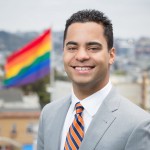 By Alex Randolph, City College Trustee
By Alex Randolph, City College Trustee
On June 14, Americans all across the country observed our annual Flag Day, an unofficial celebration of our Stars and Stripes flag’s adoption in 1777. Seamstress and flag-maker Betsy Ross sewed the original American Flag in Philadelphia. Flags have always played an important role in human history. They convey a lot about a country or community. Flags can symbolize our shared values, dreams, and ambitions, but they may also represent sorrow, hate, and oppression.
Since 1978, the Rainbow “Pride” Flag has been a critical part of Lesbian, Gay, Bisexual, and Transgender communities from all over the world. It was designed by the fabulously talented Gilbert Baker in San Francisco, after Harvey Milk challenged him to create a positive alternative to the pink triangle: a flag that would symbolize the pride of our community and would celebrate our diversity.
Despite this pledge to celebrate diversity, queers of color like myself don’t always feel like we are fully part of the larger LGBT community, and have experienced a history of marginalization and another level of bullying in our gayborhoods. Our brothers and sisters were prevented from entering certain bars. Gay dating apps are full of “no fems, trans, blacks, or Asians” statements. Have we truly become a fully inclusive community since 1978, or do we just tolerate our diversity?
I find it fitting then that this year on Flag Day, the city of Philadelphia unveiled a redesigned Pride flag that added black and brown stripes to recognize LGBT people of color. This new rainbow flag spurred negative and strong reactions immediately. What might get lost in this debate is that Philadelphia is not trying to replace the main Rainbow flag, but rather to highlight parts of the LGBT community and experiences of queer people of color that are often at times left out.
Furthermore, it is important to understand the overall context that this alternative flag was designed in. CNN reported that, over the last couple of years, Philadelphia’s Gayborhood has experienced several instances of racial discrimination, like strict dress-code policies, additional ID checks, and racial slurs. This is something we have faced right here at home in our own Castro neighborhood.
Earlier this month, I had the opportunity to visit the newly opened LGBT Center in Haifa, Israel, one of San Francisco’s sister cities. The new center prides itself on being a house for LGBT communities, a house for pride and tolerance promoting LGBT Israeli Leadership and LGBTQ Arab Activism. I was touched by the deep focus on communities and the very visible acknowledgement that our “community” is not a single entity, but is instead made up of many individual groups that all deserve a safe place to gather and build relationships with each other and amongst each other.
San Francisco Pride always seems to be able to pick the right theme at the right time. I can’t think of a better year than 2017 to have “A Celebration of Diversity.”
Let’s recommit. Let’s celebrate our individual uniqueness and the real contribution each one of us makes to our larger community. Hillary Clinton said it best: “We are stronger together.” For the next four years and beyond, we can and will build a more perfect union: The United States of Pride. I am excited! Happy Pride, everyone!
Alex Randolph is a Trustee for City College of San Francisco. He previously served in President Obama’s administration and as an LGBT advisor for Mayor Newsom. He lives in the Castro with his partner Trevor. Follow him on social media: www.twitter.com/adrandolph & www.facebook.com/AlexDRandolph
Recent Comments